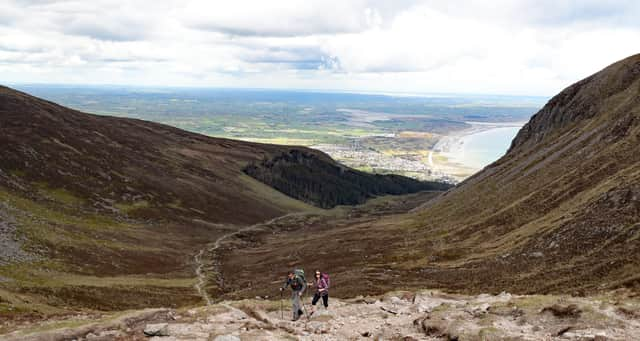Protecting the Mournes in wake of horror blaze


Since 2019, nearly 2km of path repairs have been completed, with work now being carried out on the last 200m to the summit of Slieve Donard.
The work is being carried out with locally sourced stone, 200 tons of which has been flown by the National Trust helicopter from old quarries within the Mournes.
Advertisement
Hide AdAdvertisement
Hide AdTwo new National Trust rangers, James Fisher and Theo Burke, are involved in the intensive work.
Mr Burke said the main aim of the footpath is to protect the fragile habitat from erosion as well as to provide a sustainable walking surface for the 100,000-plus visitors to Slieve Donard each year.
Just weeks ago, the mountains were damaged in a major blaze which took more than 100 firefighters several days to extinguish.
It was also the biggest gorse fire ever recorded in Northern Ireland and affected 200 hectares of National Trust land around Slieve Donard, Millstone Mountain and Thomas Mountain.
Advertisement
Hide AdAdvertisement
Hide AdAerial and ecological surveys are still being carried out to obtain a full picture of the scale of the damage and inform a restoration plan.
Mr Fisher said the original path was installed 25 years ago, but over time it has started to erode.
“We bring up stone by helicopter from the quarries on the other side of the mountains and fit that into the existing path so we have the stone going in and shoring the side up,” he said.
“We have funding for the project from the Department of Agriculture and the Environment which is to last 10 months, that came on the back of previous funding.
Advertisement
Hide AdAdvertisement
Hide Ad“Personally I have worked on this project for coming up to two years, I was with the Mourne Heritage Trust.”
The process of building the path involves digging out original stones and rebuilding it using the new stone, fitting it together and packing it in and sealing it.
“It’s all hand tools, the same tools that were used up here 100 years ago,” he said.
Mr Burke urged all visitors to stick to the paths and protect the habitat.
Advertisement
Hide AdAdvertisement
Hide AdThe pandemic has seen an uplift in the number of visitors to the mountains.
Previously there were around 100,000 visitors a year, but it is estimated to have risen by 60%.
Mr Fisher said: “A lot more people have discovered the Mournes and are making use of it, which is great to see.
“The one thing is that a lot of those people don’t have the familiarity with the mountains, so really the message is to be properly prepared for the quick-changing conditions, have the right clothes with you and proper shoes.
Advertisement
Hide AdAdvertisement
Hide Ad“But also to be aware of the various codes of practice, try and avoid lighting fires, barbecues and if you are smoking, to extinguish the cigarettes and also to bring your rubbish home and keep the place looking as good as it does.”
The National Trust has launched an online fundraising appeal to help to restore the fragile landscape and bring back vital habitats for wildlife, which has raised more than £9,000 to date.
Donations can be made at https://www.nationaltrust.org.uk/appeal/the-mournes-fires-appeal
Comment Guidelines
National World encourages reader discussion on our stories. User feedback, insights and back-and-forth exchanges add a rich layer of context to reporting. Please review our Community Guidelines before commenting.